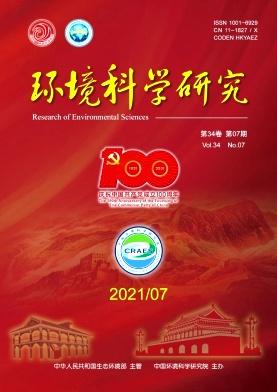Analysis of Atmospheric Pollution Status over Nanjing Based on Multi-Source Detection
Y. Zhang, H. Zhou, H. Qiao, Jun Xu, Y. Liu
{"title":"Analysis of Atmospheric Pollution Status over Nanjing Based on Multi-Source Detection","authors":"Y. Zhang, H. Zhou, H. Qiao, Jun Xu, Y. Liu","doi":"10.13198/j.issn.1001-6929.2021.07.14","DOIUrl":null,"url":null,"abstract":"Nanjing, as one of the core cities in the Yangtze River Delta, has developed industries and serious air pollution. In order to further study the pollution status in Nanjing, MODIS and CALIPSO's aerosol products were used to analyze the aerosol characteristics of Nanjing from 2011 to 2019. Then, four kinds of common reactive gases (SO2, NO, NO2 and O3) in the atmosphere of Nanjing in winter were analyzed based on the data of ground-based reactive gas analyzer. The results shows that: (1) The AOD over Nanjing showed a downward trend in the whole nine years, and the AOD could reach 0.7 in winter. The pollution degree was the highest in the four seasons. The aerosol was mainly composed of coarse particles and absorbent particles in winter. (2) The near surface atmosphere (within 2 km) of Nanjing was dominated by large particles and irregular particles. Mainly, the proportion of fine particles and regular particles gradually increased within 2-6 km, and the volume of particles changed little within 2-6 km. (3) Among the four common reactive gases in winter, the φ(NO) in the atmosphere was the most significant, and the maximum value was 160×10-9, and the change trend of NO2 and O3 was opposite. Due to the emission limitation and the promotion of desulfurization measures, and the influence of photochemical reaction, the φ(SO2) was the lowest, only about 3×10-9. Combined with OMI data, the φ(NOx) over Nanjing remained at a low level in early 2020 due to the shutdown of factories because of COVID-19. Studies have shown that the particulate pollution in Nanjing has improved in recent years, but it is still necessary to pay attention to the emission of coarse particles, and it is necessary to strictly control the emission of gaseous pollutants from factories, especially NOx. © 2021, Editorial Board, Research of Environmental Sciences. All right reserved.","PeriodicalId":21108,"journal":{"name":"环境科学研究","volume":"34 1","pages":"2306-2315"},"PeriodicalIF":0.0000,"publicationDate":"2021-01-01","publicationTypes":"Journal Article","fieldsOfStudy":null,"isOpenAccess":false,"openAccessPdf":"","citationCount":"0","resultStr":null,"platform":"Semanticscholar","paperid":null,"PeriodicalName":"环境科学研究","FirstCategoryId":"1087","ListUrlMain":"https://doi.org/10.13198/j.issn.1001-6929.2021.07.14","RegionNum":0,"RegionCategory":null,"ArticlePicture":[],"TitleCN":null,"AbstractTextCN":null,"PMCID":null,"EPubDate":"","PubModel":"","JCR":"Q2","JCRName":"Environmental Science","Score":null,"Total":0}
引用次数: 0
Abstract
Nanjing, as one of the core cities in the Yangtze River Delta, has developed industries and serious air pollution. In order to further study the pollution status in Nanjing, MODIS and CALIPSO's aerosol products were used to analyze the aerosol characteristics of Nanjing from 2011 to 2019. Then, four kinds of common reactive gases (SO2, NO, NO2 and O3) in the atmosphere of Nanjing in winter were analyzed based on the data of ground-based reactive gas analyzer. The results shows that: (1) The AOD over Nanjing showed a downward trend in the whole nine years, and the AOD could reach 0.7 in winter. The pollution degree was the highest in the four seasons. The aerosol was mainly composed of coarse particles and absorbent particles in winter. (2) The near surface atmosphere (within 2 km) of Nanjing was dominated by large particles and irregular particles. Mainly, the proportion of fine particles and regular particles gradually increased within 2-6 km, and the volume of particles changed little within 2-6 km. (3) Among the four common reactive gases in winter, the φ(NO) in the atmosphere was the most significant, and the maximum value was 160×10-9, and the change trend of NO2 and O3 was opposite. Due to the emission limitation and the promotion of desulfurization measures, and the influence of photochemical reaction, the φ(SO2) was the lowest, only about 3×10-9. Combined with OMI data, the φ(NOx) over Nanjing remained at a low level in early 2020 due to the shutdown of factories because of COVID-19. Studies have shown that the particulate pollution in Nanjing has improved in recent years, but it is still necessary to pay attention to the emission of coarse particles, and it is necessary to strictly control the emission of gaseous pollutants from factories, especially NOx. © 2021, Editorial Board, Research of Environmental Sciences. All right reserved.
基于多源检测的南京市大气污染状况分析
南京作为长三角核心城市之一,工业发达,大气污染严重。为了进一步研究南京市的污染状况,利用MODIS和CALIPSO的气溶胶产品对南京2011 - 2019年的气溶胶特征进行了分析。基于地面反应气体分析仪的数据,对南京冬季大气中常见的4种反应气体SO2、NO、NO2和O3进行了分析。结果表明:(1)南京上空AOD呈下降趋势,冬季AOD可达0.7;污染程度以四季最高。冬季气溶胶主要由粗颗粒和吸收颗粒组成。(2)南京近地表大气(2 km以内)以大颗粒和不规则颗粒为主。主要表现为2 ~ 6 km范围内细颗粒物和规则颗粒物的比例逐渐增大,2 ~ 6 km范围内颗粒物体积变化不大。(3)冬季4种常见反应气体中,大气中φ(NO)最为显著,最大值为160×10-9, NO2和O3变化趋势相反。由于排放限制和脱硫措施的促进,以及光化学反应的影响,φ(SO2)最低,仅为3×10-9左右。结合OMI数据,2020年初南京上空的φ(NOx)仍处于较低水平,原因是新冠肺炎导致工厂停产。研究表明,南京的颗粒物污染近年来有所改善,但仍需关注粗颗粒排放,严格控制工厂气态污染物的排放,特别是NOx。©2021,《环境科学研究》编委会。版权所有。
本文章由计算机程序翻译,如有差异,请以英文原文为准。


